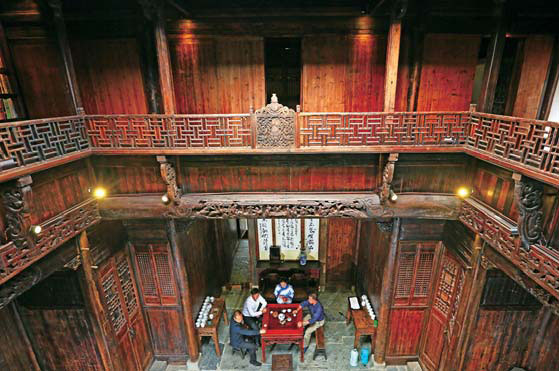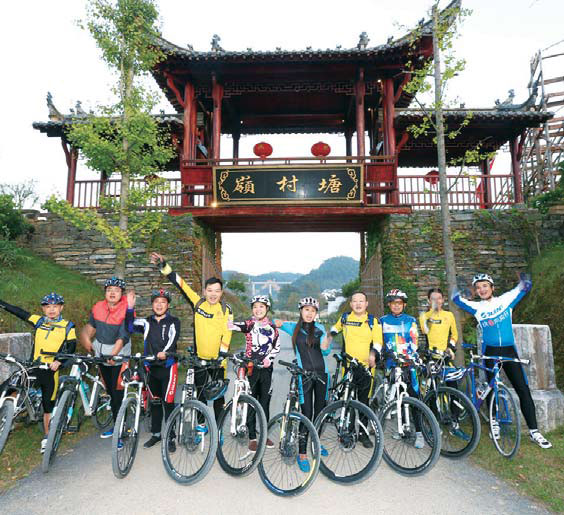Flower power
Updated: 2016-04-01 08:30
By Yang Feiyue and Shi Xiaofeng(China Daily Europe)
|
|||||||||

The county of wuyuan in Jiangxi province attracts tourists from around the country for blooming rapeseed in spring, and a variety of cultural and natural spots. Photos Provided to China Daily
Spring brings blooms to woo visitors to Wuyuan
Wuyuan burns bright yellow in spring. The blaze of blooming rapeseed attracts tourists to the county in northeast Jiangxi province from early March until mid-April.
Here, ancient villages are perched on terraced mountains that ignite in golden infernos of flowers and pools of emerald-green leaves.


"It's like a meteor on Earth," says Wang Zeshui, deputy director of the county tourism office.
Roughly 70 percent of the 67 square kilometers of rapeseed have blossomed since the beginning of March. And tourism has bloomed, too, he says. Travelers are flocking to explore the white farmhouses crowned with black ceramic shingles set among mountains and rivers.
The county received 15.3 million visitors last year, according to the tourism office. Arrivals since early March have risen 20 percent on the same period last year.
The county's Huangling alone has been receiving 20,000 tourists a day. It's a cliffside collection of hundreds of ancient ethnic Hui houses. They are perched on a slope that drops 100 meters.
Visitors have increased since the maiden voyage of the Hefei-Fuzhou high-speed train service in June, says Yan Xin, publicity manager for Ctrip, the Chinese online travel agency.
The link - colloquially referred to China's most beautiful railway - cut the travel time between Beijing and the county to less than seven hours, making weekend trips from the capital possible.
"Most people stay two to three days to take photos and enjoy the fresh air," Yan says. A two-day weekend trip from Shanghai to Wuyuan in late March and April currently costs about 600 yuan ($90; 80 euros) through Ctrip.
The local government has invested funds to attract visitors at other times of the year, too. It has earmarked 20 million yuan to develop homestays and expand rural tourism options, and has staged promotions to entice guests from cities along the Beijing-Fuzhou high-speed rail line.
The county is also drawing tourists from overseas. South Korean visitors have increased since Wuyuan became the sister city of Gokseong-gun in 2014. The Chinese county has also established relationships with more than 60 South Korean travel agencies.
Wuyuan faces competition from a multitude of Chinese destinations that showcase their rapessed blooms. So it has upped the ante with rides that literally elevate the experience - a cable car now goes up to a mountaintop proffering panoramic views, while even vaster horizons can be seen by helicopter and hot-air balloon. Oh, and there's a glass-bottomed bridge hundreds of meters above the ground.

Jiangling is one of China's four biggest rapeseed-blossom areas. The 66.7 sq km of blooms spill down terraced fields. Farmers plow and herd oxen in front of Hui houses, while women wash clothes in the river.
Sixiyancun integrates natural scenery and Hui architecture dating to the Ming (1368-1644) and Qing (1644-1911) dynasties. Blue-flagstone roads dissect the settlement that's set among green hills and rivers, not to mention springtime blooms.
Zheyuan offers a glimpse into an old-fashioned and unassuming lifestyle. It houses former residences of several celebrities, such as Zhan Tianyou, the "father of China's railroads", and martial arts novelist Louis Cha. It's a great place for road trips, crossing hundreds of scenic sites and antiquated hamlets.
Moon Bay features a crescent-shaped terrain surrounded by peaks and waterways. Golden flowers and green tea plants color the land around humble houses. Mist rises from the mounts, especially in the morning.
Meanwhile, Wangkou is lined with streets that are up to 1,000 years old and has ancient structures like imperial officers' residences and studies. It was once a prosperous transportation hub and has retained the architectural legacy of that era.
This legacy may reincarnate when a new high-speed rail connecting Jiujiang in Jiangxi to Quzhou in Zhejiang province is completed next year.
Marketing campaigns have already been held in areas the line passes, Wang says.
Contact the writers through yangfeiyue@chinadaily.com.cn
Today's Top News
A fresh start
Bookshops reinvent themselves
Xi-Obama bilateral talk to advance ties
Foreign companies reassured on new Internet rules
Beijing and Prague form new key link
Trump drops pledge to back Republican nominee
China, Czech Republic set up strategic partnership
EgyptAir hijacker arrested, all passengers freed
Hot Topics
Lunar probe , China growth forecasts, Emission rules get tougher, China seen through 'colored lens', International board,
Editor's Picks

|

|

|

|

|

|






